What Is Root Rot?
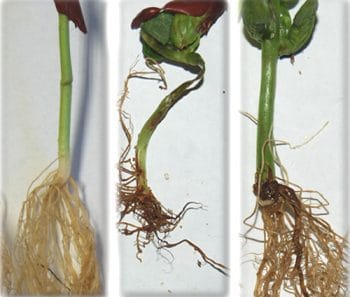
Root rot is a condition found in both indoor and outdoor plants, though it is more common in indoor plants with poor drainage. As the name states, the roots of the plant literally begin to rot.
Usually, this is a result of over watering. In houseplants, it is a very common problem due to the containers used. It’s slightly less common outdoors because excess moisture has more space to disperse.
If left untreated, root rot will kill the entire plant. The first symptoms of root rot occur within the soil, making it difficult to identify offhand. For this reason, gardeners and homeowners are often not aware of the problem until it is advanced.
When plants start showing symptoms of root rot, such as yellow leaves or stunted growth, take action immediately. By this point, the issue has been present long enough to affect the visible portion of the plant, so you want to be proactive in salvaging it as quickly as possible.
PDF – How to Treat and Prevent Root Rot
What Causes Root Rot?
Excessive water might seem like the cause of root rot. However, the problem starts because too much water promotes the ideal environment for the truth culprit: Fungus. When the soil is too dense for water to drain out efficiently, this creates an ideal environment for fungal growth.
This is why container plants are most at risk, although garden plants are not immune to the issue. Most garden-based root rot can be prevented by taking steps to improve soil drainage before planting.
Identifying Root Rot
Root rot can be identified by the presence of soft, brown roots. The root system of a healthy plant should be firm and white. But when the soil is soggy, fungal spores multiply and feed on the root system.
As this process advances, once-healthy portions of the roots turn brown and mushy. They begin to die from malnourishment, and from being fed on by the fungus.
This damages the plant’s ability to absorb nutrients adequately, and the deficiency becomes apparent in the condition of its foliage. Leaves begin to wilt and turn yellow or fall off, growth slows, and blooming may be delayed.
In the most extreme cases, when conditions are ideal for the fungus to spread quickly, plants can die within a mere 10 days. This is why it’s critical to take action as soon as you become aware of root rot.
If you notice these symptoms in a plant, loosen the soil around the base with a hand trowel or shovel, and remove the plant from the soil. Gently shake the soil from the roots and inspect them for rot.
Treating Root Rot
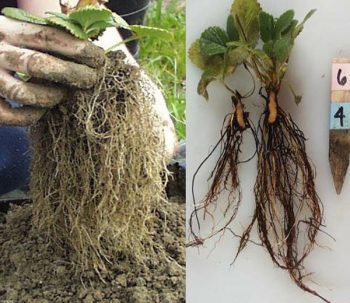 Now you have identified root rot, you must determine if the plant can be saved. If the root system has already become decayed and mushy, then it is unfortunately too late.
Now you have identified root rot, you must determine if the plant can be saved. If the root system has already become decayed and mushy, then it is unfortunately too late.
Although, if a portion of the root system remains firm and white, such as that shown in the photograph, then there is still hope. With fresh soil and proper drainage, you can help the plant restore itself to full health.
Proper Steps For Indoor Plants:
- Prepare it for replanting by cleaning the roots gently under running water and removing all rotting roots.
- Sterilize the shears or scissors with a solution of 1 part bleach to 3 parts water to avoid spreading fungal spores to other plants or soil.
- Cut the healthy root just above the damaged area. Work quickly to replant within a few hours.
- Use a container with several small drainage holes, or one large drainage hole, to ensure proper water drainage. **When reusing old containers, first disinfect them by soaking in a solution of 1 part bleach to 9 parts water for half an hour.
- DO NOT reuse the old soil, and resist using garden soil, which can contain a number of pathogens (fungus). Fill the container with 2 parts store-bought soil, 2 parts peat moss and 1 part perlite.
- Dig a hole in the soil at least twice the width of the root ball to avoid crowding roots. Place the plant in the hole, cover and water thoroughly.
Treating Outdoor Gardens:
In most situations, improving soil drainage and adding amendments is sufficient to prevent future problems. Extreme cases of root rot may require garden soil replacing. Take the following steps to replant in a garden:
- Identify sloped and low-lying areas that collect water at the base or against a solid structure. Add drainage channels to direct water away from the garden space if needed. This process ensures that water drains away from garden beds and buildings, rather than pooling.
- To prepare for planting, improve drainage in dense soils by increasing organic material. Soil amendments can be added to help make the nutrients in the soil more available to your plants.
- Dig a hole in the soil at least twice the width of the root ball to avoid crowding roots. Place the plant in the hole, cover and water thoroughly.
Final Thoughts
Root rot is a serious issue for gardeners, and treating the problem as soon as symptoms occur greatly increases the chances of saving affected plants. Prevent fungus from thriving in soggy soil by providing good drainage and a healthy soil environment.
Need assistance in creating a new flower garden or maintaining a sharp looking lawn? Contact Ryno Lawn Care for the best professional lawn and landscaping company in the D/FW Area.
Related Links: How to Improve Clay Soil For Lawns

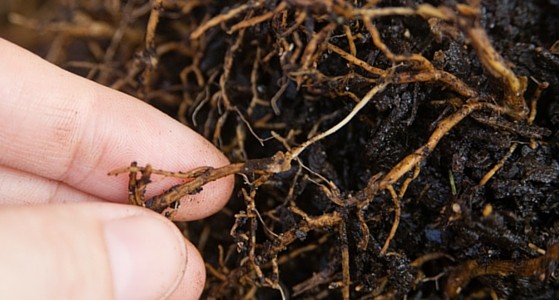

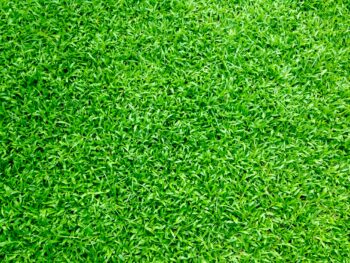

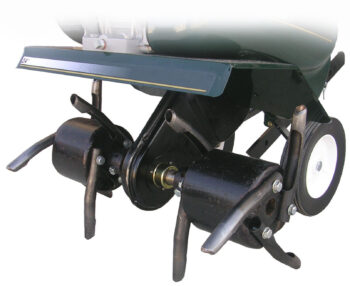
One Response
The best understandable informative post you shared on this page for the treatment of root disease by spraying a medicine to kill the germs produce under the root of a plant’s located in a different lawns with the help of garden harvest roller machine ,if you interested to remove this kind of disease rapidly than the best easiest solution is to start providing a proper water to all the plants of a lawns and also clean the leaves of a plants with the help of water pressure which help you to protect your plants from the germs of a root disease ,My suggestion is to call a specialist of a plant’s for the visit of lawns to identify the disease of roots and proper check up in a week . which is helpful for you to take a proper care of plants during a process of look after for a lawn .
Thanks.